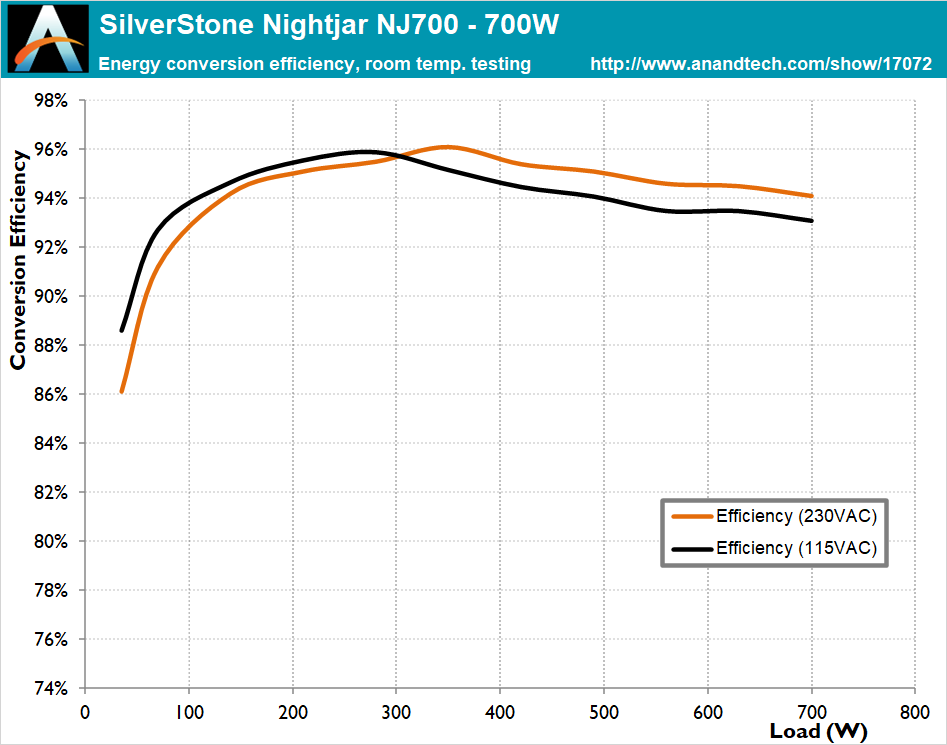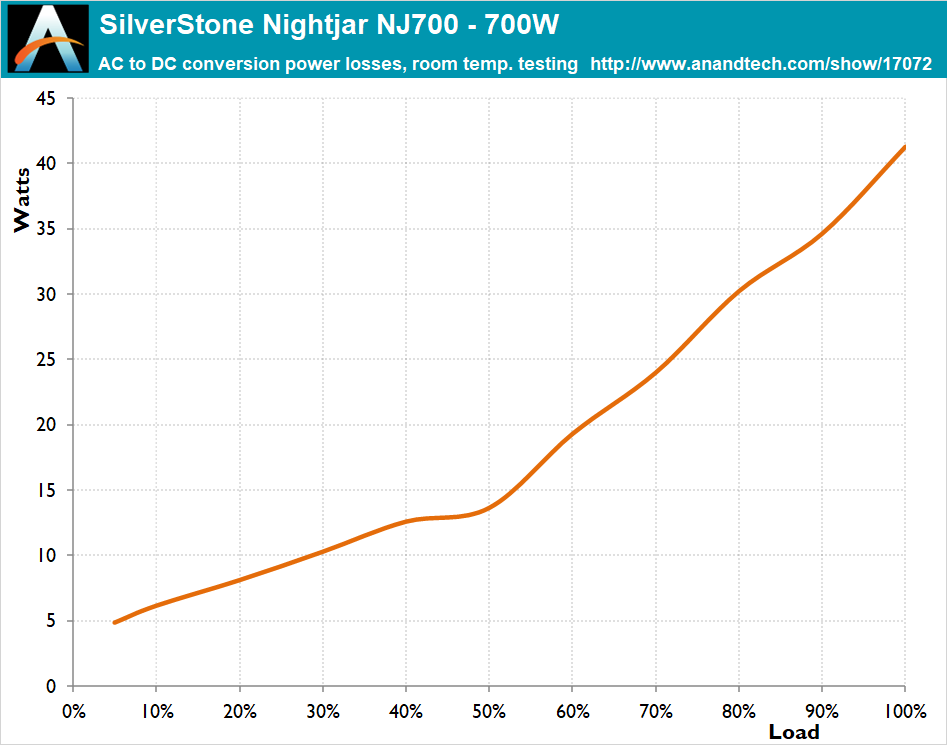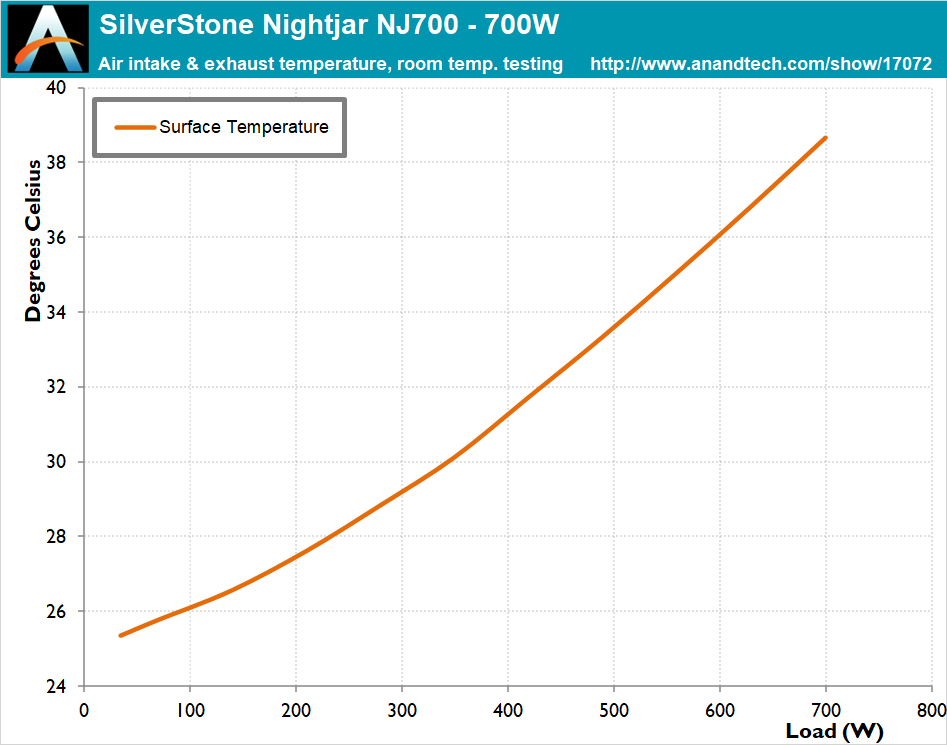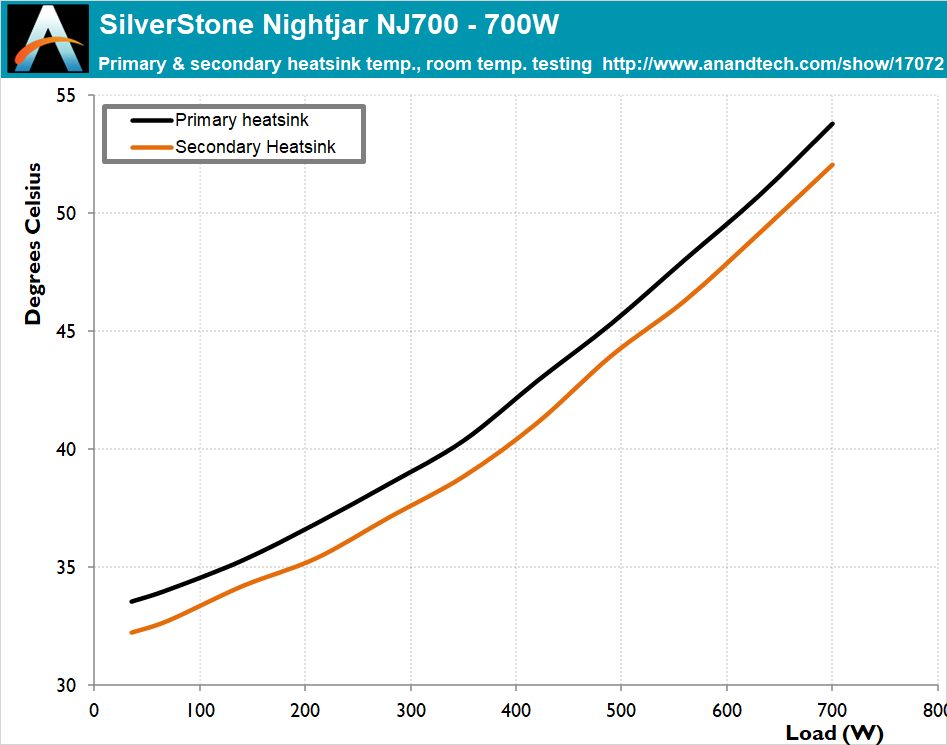The SilverStone NightJar NJ700 Passive PSU Review: Silent Excellence
by E. Fylladitakis on November 29, 2021 8:00 AM EST- Posted in
- Cases/Cooling/PSUs
- PSUs
- SilverStone
- Passive Cooling
Cold Test Results (~22°C Ambient)
For the testing of PSUs, we are using high precision electronic loads with a maximum power draw of 2700 Watts, a Rigol DS5042M 40 MHz oscilloscope, an Extech 380803 power analyzer, two high precision UNI-T UT-325 digital thermometers, an Extech HD600 SPL meter, a self-designed hotbox and various other bits and parts. For a thorough explanation of our testing methodology and more details on our equipment, please refer to our How We Test PSUs - 2014 Pipeline post.
Due to the unique thermal design of the Nightjar NJ700, we had to change our testing methodology quite a bit. As there is no airflow to assess, we placed a sensor on the bottom side of the chassis and measure its surface temperature instead. Note that these thermal results are not directly comparable with those obtained by testing regular air-cooled products.
As expected from a fanless PSU with this kind of power output, its efficiency is extremely high. Our measurements indicate that the SilverStone NJ700 surpasses the 80Plus Titanium requirements regardless of its input voltage. It has an amazing 95% average efficiency across the entire nominal load range when powered by an 230V AC source, which drops down by just 0.6% when the input is lowered to 115V AC. The efficiency at just 5% load is above 86% and the peak efficiency is above 96%.
As expected from any well-designed PSU without active cooling, the surface temperature increases almost linearly and in near-perfect alignment with the unit’s thermal losses. The surface temperature does reach over 38 °C, which is to be expected, as the body of the PSU itself partially acts as a heatsink. The heatsinks of the PSU do reach temperatures over 50°C when the power supply is heavily loaded but that is a perfectly safe figure for an advanced PSU. The primary side is getting a little bit hotter than the secondary side.














46 Comments
View All Comments
Oxford Guy - Monday, December 27, 2021 - link
I tracked down a review of Seasonic PSUs (SS-1050XP3 & SS-1200XP3) from this site for those claiming fans are no problem in PSUs. The first red flag is the lifespan of the fan:'Seasonic went with a San Ace 9S1212H403 120mm fan in both of their newest models.
The life expectancy of this fan is 40,000 hours, a rather mediocre rating for similar devices, translating to about 4.5 years of 24/7 use at 60°C, albeit this rating also is for a free, unobstructed air path (zero static pressure, max airflow).'
4.5 years is a lot less than infinite, since a fanless PSU doesn't have a fan lifespan issue.
Then, we get to the noise, which is a far far cry from 'silent', even in the cold tests:
SS-1050XP3 results, cold test (decibels at the specified wattage):
'The 120mm fan can be clearly heard at just 40% load and its speed climbs rapidly as the load increases, surpassing even 50dB(A) at very high loads. At such noise levels, the Platinum SS-1050XP3 can be clearly heard from rooms away.'
400 — 32
500 — 36
600 — 38
700 — 42
800 — 46
900 — 48
1000 — 50
1050 — 51
SS-1050XP3 results, hot test:
200 — 34
300 — 37
400 — 39
500 — 44
600 — 46
700 — 49
800 — 51
900 — 53
1000 — 55
1050 — 55.5
I guess I was being too kind by talking about the concern being a PSU that's loud enough to be heard from rooms away. Ear-splitting is apparently another tier here:
'The behavior of the cooling system remains similar with the PSU inside our hot box, with the exception that the fan is even more aggressive, starting at just 20% load and with its speed climbing rapidly as the load increases. At 50% load, under such conditions, the Seasonic Platinum SS-1050XP3 already is a loud PSU, with the sound pressure reaching ear-splitting levels at >80% load.'
SS-1200XP3 cold test:
600 — 39
700 — 41
800 — 44
900 — 47
1000 — 49
1100 — 52
1200 — 52
SS-1200XP3 hot test:
300 — 37
350 — 39
400 — 40
500 — 43
600 — 46
700 — 48
800 — 51
900 — 52
1000 — 54
1100 — 56
1200 — 56
PSUs like those sell fanless units to people like me.
Oxford Guy - Monday, December 27, 2021 - link
Sound levels are from 1 metre away. Forgot to mention that.Wrs - Tuesday, December 28, 2021 - link
This is silly. Not only are these 5 year old designs, but can you explain how someone worried about noise would be drawing 1000W? The PSU has a fan to cool ~120W, but what's cooling the 1000W? If I were super worried about noise, like using a PC in a broadcast studio without mic noise cancellation, I would probably get a system of no more than 250W typical, with a 650W+ hybrid PSU where the fan doesn't even spin at 250W. Effectively fanless in production, turns on during emergency/off hour loads to save the PSU.I'm not worried one bit about fan life expectancy these days. It's trivial to find a start-stop fan PSU. Mine from 11.5 years ago is ball bearing and fully start-stop, though that was rare back then. These days mainstream FDB is used with hysteresis. Remember there's capacitor life expectancy in a PSU and mobo. For every 10C delta, expect a doubling or halving of life. A PSU intake is not going to be 60C, which is scalding hot. A modern case has the PSU draw air straight from ambient
Oxford Guy - Tuesday, December 28, 2021 - link
'This is silly.'I'm amazed you're still at it.
Wrs - Tuesday, December 28, 2021 - link
Side note. Human speech typically runs 50dB at home, 60dB in public. I'd hope neither is ear-splitting!Here's a PSU that measures 20dB at 1300W. The review is almost 4 years old, but the unit was well ahead of its time, close to the pinnacle of efficient design, you could say. Uses technologies still not commonplace, especially GaN FETS. https://www.techpowerup.com/review/corsair-ax1600i...
Oxford Guy - Tuesday, December 28, 2021 - link
Even quieter is a fanless unit.